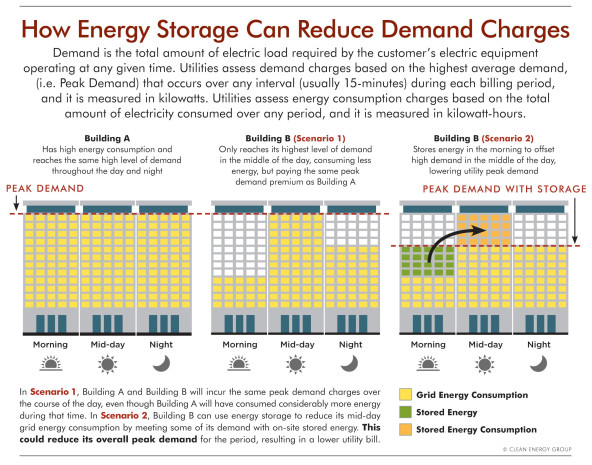A few months ago, Tesla’s Elon Musk unveiled his new battery storage technology with spectacular images of the planet glowing behind him. He said he was selling the Powerwall and Powerpack batteries as a way to help people save the world from climate change. These battery systems, combined with solar power (solar-plus-storage), could move the world toward a fossil fuel-free future.
But there’s a catch. Since that product launch, most customers seem to be buying the batteries primarily to save money, and not necessarily to save the planet. That’s not surprising because Tesla and its partner SolarCity, as well as other solar-plus-storage start-ups, are promoting their products to large corporate customers, such as Walmart, that can use them to reduce their utility bills in states like California and New York.
This is not to criticize their business strategies. It’s a good thing for the economic savings of solar+storage to drive its adoption, with clean energy as a bonus. Early adopters of disruptive technologies are typically the well-to-do and, so far, energy storage is no exception.
But perhaps we can encourage Telsa and other solar players to try to move more quickly through this early-adopter stage, and inspire other sectors like governments and affordable housing to become early adopters themselves. It would be unfortunate if the people who need this promising technology the most—elderly, poor people, and other vulnerable populations—become the last to benefit.
Are you enjoying this article? Read more like this, plus SSIR's full archive of content, when you subscribe.
Many poor, elderly, and disabled people live in buildings with electric bills that have the same kind of high “demand charges” facing large private companies. Solar-plus-storage can reduce demand charges on facilities like these that house the economically or physically vulnerable. Taming utility demand charges (which are on the rise) makes for a good strategy for helping low-income people manage their energy bills.

But more importantly, solar-plus-storage can protect people and save lives. Remember what happened after Superstorm Sandy and Hurricane Katrina, when many low-income families and seniors were stranded in high rises and hospitals because the electricity went out and backup diesel generators failed? If those buildings had solar+storage systems to power critical loads like lighting, heating and cooling, and water pumps, they could have sheltered in place, in a safe harbor from the storms.
And we know from our latest research, the first detailed analysis of the economics of solar-plus-storage in affordable housing in the United States, that these systems can pay for themselves in as little as 3.5 years and deliver an economic return to building owners, providing protection and power resilience at little to no net cost.
The Drivers and Limits of the Emerging Energy Storage Markets
We can bend the arc of this solar-plus-storage technology trend toward public purposes now, not as a last resort but as a matter of market design and social justice. But to capture this opportunity, we must first fully understand the drivers and limits of these emerging energy storage markets.
First, it’s important to understand that installation of solar-plus-storage technologies by large private companies is taking off mainly because batteries do a great job of reducing demand charges on their utility bills. What are those charges? They’re the fees that utilities charge larger commercial customers based on their highest peak power use over a billing cycle (usually a month or so), regardless of how much electricity they actually use. It’s like a charge on the highest, single power spike—similar to, and about as popular as, Uber’s congestion pricing. In some places, demand charges can comprise over half the bill. That makes reducing them a huge savings opportunity.
Second, it’s important to understand that currently, solar systems are not usually configured to run independently from the grid—when the grid goes down, the solar systems do too, whether the outage is from a storm or an earthquake. That leaves huge amounts of untapped energy capacity unused and wasted, because solar power could charge batteries to provide resiliency to ride out power emergencies. For the most part, new energy storage products for corporate accounts aren’t being set up in this resilient power mode.
Solar-plus-storage can do so much more than reduce large companies’ utility bills. There is a higher need. The problem is that, while upscale private markets are taking off, solar-plus-storage has yet to be marketed actively to serve important public purposes for which it is uniquely suited.
Building the Bridge
So what will it take to bridge the clean energy divide?
First, companies like Tesla, SolarCity and SunEdison should aggressively expand their marketing, now, to include solutions for affordable housing and buildings for seniors and vulnerable populations, as well as all critical public facilities. Targeting only corporate savings shortchanges the technology’s social promise.
Second, governments should provide more funding and policy support to deploy resilient power for public safety and community resiliency.
Third, those advocating for vulnerable populations (and those populations themselves, to the extent possible) should demand equal access to these new clean energy technologies.
Fourth, environmental and community development experts should support solar-plus-storage as advocacy for low-income families and climate change initiatives.
And finally, banks, foundations, and socially responsible investors must find creative ways to finance these technologies to serve critical public needs.
Elon Musk deserves tremendous credit for ushering battery technology into the solar space. His ambitions seem large enough to confront and solve another looming social problem: how to ensure that the most vulnerable populations are part of this next energy revolution.
Support SSIR’s coverage of cross-sector solutions to global challenges.
Help us further the reach of innovative ideas. Donate today.
Read more stories by Lewis Milford.

